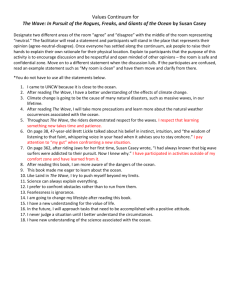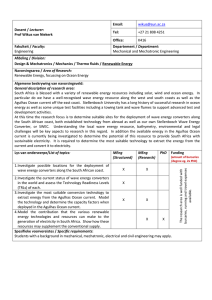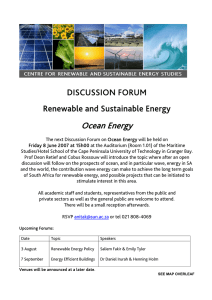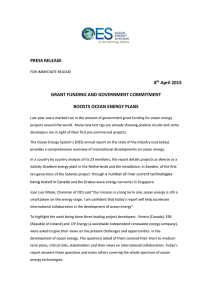BULLETIN
advertisement
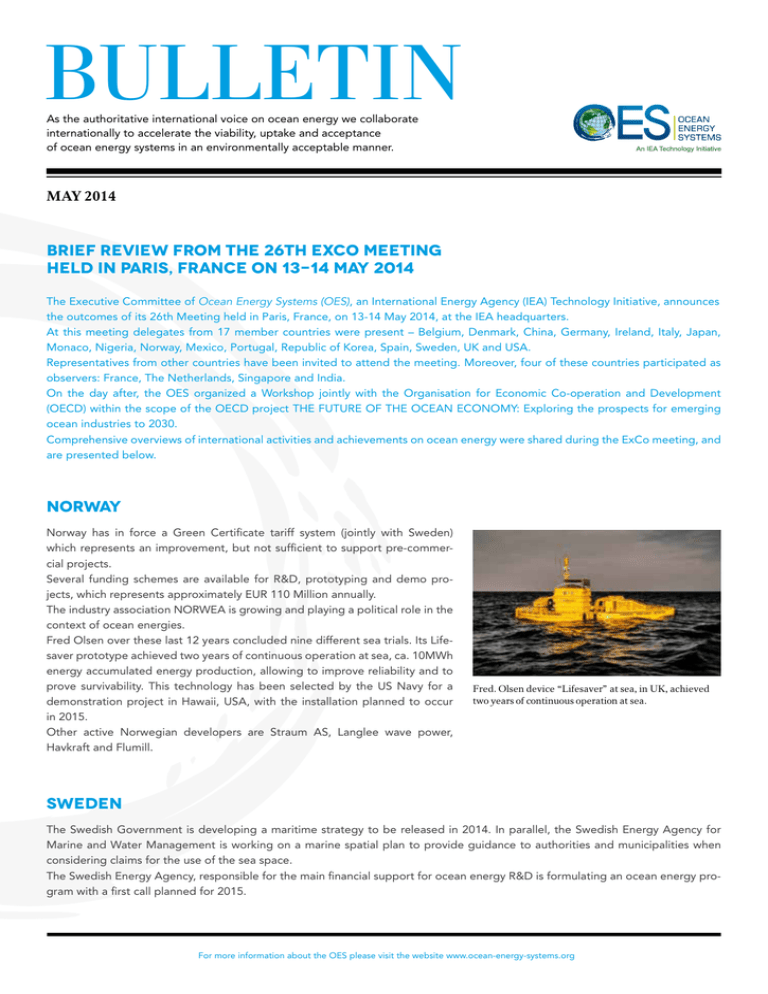
BULLETIN As the authoritative international voice on ocean energy we collaborate internationally to accelerate the viability, uptake and acceptance of ocean energy systems in an environmentally acceptable manner. MAY 2014 Brief review from the 26th ExCo Meeting held in Paris, France on 13-14 May 2014 The Executive Committee of Ocean Energy Systems (OES), an International Energy Agency (IEA) Technology Initiative, announces the outcomes of its 26th Meeting held in Paris, France, on 13-14 May 2014, at the IEA headquarters. At this meeting delegates from 17 member countries were present – Belgium, Denmark, China, Germany, Ireland, Italy, Japan, Monaco, Nigeria, Norway, Mexico, Portugal, Republic of Korea, Spain, Sweden, UK and USA. Representatives from other countries have been invited to attend the meeting. Moreover, four of these countries participated as observers: France, The Netherlands, Singapore and India. On the day after, the OES organized a Workshop jointly with the Organisation for Economic Co-operation and Development (OECD) within the scope of the OECD project THE FUTURE OF THE OCEAN ECONOMY: Exploring the prospects for emerging ocean industries to 2030. Comprehensive overviews of international activities and achievements on ocean energy were shared during the ExCo meeting, and are presented below. Norway Norway has in force a Green Certificate tariff system (jointly with Sweden) which represents an improvement, but not sufficient to support pre-commercial projects. Several funding schemes are available for R&D, prototyping and demo projects, which represents approximately EUR 110 Million annually. The industry association NORWEA is growing and playing a political role in the context of ocean energies. Fred Olsen over these last 12 years concluded nine different sea trials. Its Lifesaver prototype achieved two years of continuous operation at sea, ca. 10MWh energy accumulated energy production, allowing to improve reliability and to prove survivability. This technology has been selected by the US Navy for a demonstration project in Hawaii, USA, with the installation planned to occur in 2015. Other active Norwegian developers are Straum AS, Langlee wave power, Havkraft and Flumill. Fred. Olsen device “Lifesaver” at sea, in UK, achieved two years of continuous operation at sea. Sweden The Swedish Government is developing a maritime strategy to be released in 2014. In parallel, the Swedish Energy Agency for Marine and Water Management is working on a marine spatial plan to provide guidance to authorities and municipalities when considering claims for the use of the sea space. The Swedish Energy Agency, responsible for the main financial support for ocean energy R&D is formulating an ocean energy program with a first call planned for 2015. For more information about the OES please visit the website www.ocean-energy-systems.org BULLETIN MAY 2014 Seabased Industry AB, a spin-off company from Uppsala University, together with the utility Fortum are now building a commercial wave energy plant outside Sotenäs test site. The first 1 MW project is planned to be ready soon and will be followed by an evaluation time of nine months before the next step (9 MW). Other active developers are Vigor Wave, Waves4Power, Minesto, Corpower, Current power AB and Ocean Harvesting Tech AB. Portugal The National Ocean Strategy 2013-2020 launched by the Portuguese government last year includes an action plan foreseeing the development of marine energy. In April this year, the law 17/2014 established the Bases of the National Maritime Spatial Planning Policy (POGEM). Complementary laws will be issued in October 2014 and it is expected that these laws will simplify the legal procedures related to the introduction of marine energy activities. IST continues with the development of the OWC spar buoy. After the tests conducted at NAREC, UK (1:16 scale) a new series of tests (1:32 scale) is being planned for July 2014 at University of Plymouth. Both tests are making use of the EU Marinet project. OceaNET, a European funded Training Network of 10 European Partners, held a welcome Seminar, in Santander, Spain on the 5th of May 2014, with all the early stage researchers recruited in the area of floating offshore wind and wave energies. The project began in September 2013 and will be carried out over a period of four years (www.oceanet-itn.eu) under the coordination of WavEC Offshore Renewables. Pico plant continues operational: in April, the plant production was 4851 kWh. Spain The Spanish ocean energy industry is progressing with the participation of big companies (IBERDROLA, ABENGOA, REPSOL) and the involvement of regional governments (Basque Country and Canary Islands). Bimep wave energy test site in the Basque country is planned to start operation soon and three projects are currently under negotiation with the first device expected to be tested in the water by mid-2014. The Oceanic Platform of the Canary Islands (PLOCAN), a Public Consortium operating an offshore wave energy test site infrastructure is working on the installation of the electrical cable. The Spanish developer Wedge-Global recently initiated its non-grid sea trials with a full scale prototype (200 kW) in PLOCAN. Furthermore, two small companies are progressing with their tidal current projects, GESMEY-PROCODAC and MAGALLANES. Mutriku OWC plant, has almost three years of operation with 400MWh average annual production. Wedge-Global sea trials in PLOCAN, in early 2014. At the end of 2013, the Basque Energy Agency EVE launched a €3m funding programme to support sea tests of marine renewable projects. The submitted proposals are presently under evaluation. Monaco The Principality of Monaco is the newest country that joined OES last year in June. This action was part of the Government concerns for combating climate change and recognizing the relevance for international cooperation. Monaco has a dedicated funding instrument, the Energy-Sustainable Development Fund for the promotion of renewable energies. The sea is used as a renewable energy source for the development of heat pump systems. Many buildings located on the coast benefit from this reversible system, for heating in winter and air-conditioning in summer. A technical committee was set up to investigate the possibility of installing new technologies in Monaco waters. For more information about the OES please visit the website www.ocean-energy-systems.org BULLETIN MAY 2014 Belgium Gen4Wave platform, a stakeholder’s organization is presently under construction willing to ensure that Flemish industries can position themselves within the value chain of wave and tidal energy. FlanSea R&D project (2010-2013) conducted by a consortium of 6 companies and Ghent University led by DEME Blue Energy, has been concluded and a report will be soon released. The goal of this consortium was to develop a Flemish wave energy converter adapted to moderate wave climates. Laminaria, after the tests at scale 1/10 in a wave tank will progress to sea trials with government funding. Mermaid project, a partnership of Belgian companies consisting of OTARY RS (65%) and Electrabel, Group GDF SUEZ (35%), plan to include a wave farm up to 20 MW rated wave power, 50 km offshore, between the wind turbines, exploring multiple possible synergies between wave and wind. The wave energy technology is still to be selected. Gen4Wave platform, a stakeholder’s organization is presently under construction willing to ensure that Flemish industries can position themselves within the value chain of wave and tidal energy. Denmark Denmark has in place a strategy for advancing the wave energy sector prepared by a Danish Partnership led by the Wave Energy Research Group from the Department of Civil Engineering at Aalborg University, Energinet.dk and the Danish Energy Agency, which include developers, wave energy associations and technology institutes. The plan proposes the introduction of a Feed-in Tariff from 2015 of 600€/MWh for a limited production of 7000 MWh/y over maximum 10 years, aiming to attract private investment. Presently, there are 9 active wave energy developers and a lot of activity is going on at the demonstration wave energy test site Danwec (Green lab) which is operated by Aalborg University. Germany The German Government is funding 6 projects on ocean energy with a total 7 M€ related to the development of components and concepts. The German Government is funding 6 projects on ocean energy with a total 7 M€ related to the development of components and concepts. Four German manufacturers are progressing with relevant activities in tidal current energy: • MCT operates within the Hydro & Ocean Business in Siemens Energy and is developing two projects: the Kyle Rhea tidal array project (4 x 2 MW Seagen S) in narrow strait between Isle of Skye and Scottish mainland and the Anglesey Skerries tidal array (5x2 MW). • Voith Hydro Ocean Current Technologies GmbH with a Joined venture with RWE Innogy is planning the next phase of commercialization of the full scale prototype technology in small farms. • The German marine propulsion specialist Schottel group - developer BLACK ROCK TIDAL POWER INC, has been awarded one of two demonstration berths at FORCE, Canada. The aim is to install a full-scale demonstrator using 36 SCHOTTEL STG turbines combined with the TIDALSTREAM TRITON support structure resulting in a 2.5 MW device. • Andritz Hydro GmbH under the Andritz Group based in Austria Andritz Hydro Hammerfest established in 1997 in Norway represents the technology provider in the tidal power business and is developing drive train concepts for tidal turbines with around € 1 million funding from the German Ministry for the Environment. For more information about the OES please visit the website www.ocean-energy-systems.org BULLETIN MAY 2014 Ireland The Offshore Renewable Energy Development Plan was launched by the Irish Government in February 2014. There has been quite an extensive strategic environmental assessment done in which a lot of public consultation has been involved. The essence of this plan is to identify areas where offshore renewable energies can be developed. The plan includes a multi-annual funding program with an overall budget of €26M, and proposes the development of a ReFIT support scheme. It further focuses on key aspects such as energy export opportunities, supply chain development, planning and consent, environmental monitoring and infrastructure (Grids and Ports) aiming to put in place a coordinated strategy for the development of Ireland’s offshore renewable energy resources. UK UK shows a strong committed in developing marine energies: • An updated UK Renewables Energy Roadmap was published in 2013 highlighting the need to reassess deployment pipeline to 2020. • The Low Carbon Innovation Generation Coordination Group (LCICG) published its Strategic Framework in February 2014, with a chapter on Marine Energy. • The Northern Ireland Executive hosted a meeting in Belfast in February 2014, with a focus on the deployment of the first tidal arrays. • In December 2013 wave and tidal stream were both awarded a strike price of £305/MWh per generation station up to 30MW. • DECC has now taken the approach to consider different policies for the support of wave and tidal stream and commissioned a review of the wave sector which will give information about the next steps of policy development. In what concerns tidal stream, most of the work has been focused on the first arrays. • WaveHub in Cornwall now has all berths reserved with the first wave energy deployment expected this year. Crown Estate initiatives: • Launch of a market engagement process to understand interest in future tidal range and lagoons projects around the UK. • Closing phases of the current wave and tidal stream demonstration leasing process, expected to be completed by mid June 2014. • Detailed due diligence on a short list of projects during 2014 for the £20M Array Investment. Other relevant funding allocated to marine energy recently announced in Scotland: • £6 million to the further testing of new wave and tidal energy prototypes in the seas around Scotland. • £13 million, of the Scottish Government’s Marine Renewables Commercialisation Fund (MRCF) to be shared by Aquamarine Power Limited and Pelamis Wave Power and further 2.8 million of MRCF funds to be allocated for five marine energy innovation projects. Japan In response to the call launched by the government for marine energy demonstration sites, several proposals have been submitted and are now being analysed. NEDO has a funding program in place that will run until 2017. Moreover, the following budgets per year have been allocated to this aim: 1 Billion JPY for 2013, 2 Billion JPY for 2014, 2.5 Billion JPY for 2015 and 2.7 Billion JPY for 2016. The Nippon Kaiji Kyokai (a Japanese ship classification society, known as ClassNK) has issued its first Approval In Principle (AIP) for submersible floating structure of ocean thermal energy conversion (OTEC) developed by the shipbuilder Japan Marine United Corporation (JMU) in cooperation with Saga University. Republic of Korea In Korea, four players are active on the development of tidal current energy projects with public funding: the Korea Maritime and Ocean University (KMOU), the Hyundai Heavy Industry Co., Ltd. and the Korea Institute of Ocean Science and Technology (KIOST) and Inha University. Six wave energy R&D projects with public funding are being conducted by KIOST, KMOU and four Korean Universities, concerning the development of different concepts. For more information about the OES please visit the website www.ocean-energy-systems.org BULLETIN MAY 2014 These wave and tidal current energy projects have been funded by the Ministry of Trade, Industry and Energy and the Ministry of Oceans and Fisheries. Other projects with national funding include educational programs on ocean energy, hybrid power systems and international standard. In OTEC, the government has in place a strategy for the development of a 100MW OTEC project and its operation in tropical waters. Experiments have been initiated in the last two years with 20KW and 200kW OTEC demonstration units and the next stage is the design of a 1 MW plant. China Haineng III 2×300 kW vertical tidal current energy device In December 2013, the Marine Renewable Energy branch of China Association of Oceanic Engineering (CAOE) has been created, with an official opening ceremony. More than 130 members of 49 organizations from marine energy sector were present. The “Marine Renewable Energy Development Program (2013-2016)” has been launched by end of last year. Governmental support initiatives for demonstration test sites have been initiated and three regional testing sites are already confirmed (Guangdong, Zhejiang and Shandong). Several projects on wave and tidal energy are progressing: • The Eagle I 10 kW floating wave energy system • Haineng I 2×150 kW vertical tidal current energy device • Haineng III 2×300 kW vertical tidal current energy device • Haiming I 10 kW bottom-mounted tidal current turbine Two marine energy demonstration projects on isolated islands were developed and will be deployed soon: • 500 kW demonstration project on Zhaitang Island (200 kW floating tidal energy, 100 kW fixed tidal energy, 150 kW wind energy and 50 kW solar panel). • 500 kW demonstration project on Wanshan Island (300 kW wave energy and 200 kW wind energy). Nigeria OTEC has great potential in Nigeria, not only for energy production but also due to its multi-products such as hydrogen (for fuel cell), ammonia (for fertilizer), methanol, air-conditioning, edible salt, aquamarine nutrients etc. Furthermore, the job creation potential and the production of potable water are additional incentives for the establishment of OTEC plant in the medium term (10 -15 years). Nigeria, as well as other Sub-Sahara African countries like Benin, Cameroon, Togo, Ghana and Senegal have potential for the adoption of the multi-product OTEC technology. It is however recognized as an urgent need for the respective governments to support the pre-feasibility studies that will define and identify the locations of appropriate sites and develop the Business Plan for the installation of OTEC facilities to generate electricity and other by-products. It is in recognition of this, that a Center for Ocean Renewable Energy Resources-CORER, is been proposed for establishment by the Federal Government of Nigeria. Mexico The Comisión Federal de Electricidad, Mexican state-owned electric utility is working with the company Energy Forever to deploy a first pilot power plant at Sauzal’s breakwaters with a rated capacity of ~200 kW, planned by the end of 2014. A private Mexican company, Potencia Industrial, and a North American company Aquantis Inc. joined efforts with the intention to build and deploy tidal stream energy devices at the Cozumel canal in Mexico. Mexico is looking to specific aspects of ocean energy utilization as hydrothermal vents and boiling sea floor using OTEC technology for high temperature difference. The Mexican government through the Secretary of Energy has commenced formal talks with a number of stakeholders to form a research centre for Marine Renewable Energy Technologies. The centre will identify and gather National experts, Academic and Private Institutions that work on the subject to promote collaboration. The ultimate goal of the centre is to accelerate the flourishing of a National Marine Energy Industry. For more information about the OES please visit the website www.ocean-energy-systems.org BULLETIN MAY 2014 USA DOE is committed to the development of innovative technologies for ocean energy through the Water Power Program’s efforts in R&D in this area. The budget of $41.3 million for 2014 is the highest budget ever allocated to marine energies. New initiatives: • OpenEI – Open Energy Information (OpenEI) is a knowledge sharing online community dedicated to connecting people with the latest energy information and data. See http://en.openei. org/wiki/Main_Page. OpenEI hosts a water power community forum for providing feedback to DOE, and is now hosting the MHK Technology Database and Hydrodynamics Testing Facilities Database. • The MHK LCOE Reporting Guidance and MHK Cost Breakdown Structure – These guidance documents are available through the Water Power gateway on OpenEI and are still open for feedback from users and industry through the OpenEI Forum. The documents have been published in response to the industry’s expression of willingness to share technology data for a fair evaluation of technologies and DOE’s need for transparent data presented in a standard format to evaluate marine energy technologies. The MHK Levelized Cost of Energy Reporting Guidance and Cost Breakdown Structure reports can be reviewed and downloaded from http://en.openei.org/wiki/ Gateway:Water_Power. • Demonstrations projects at Navy Wave Energy Test Site – The DOE seeks to support the deployment of two close to full scale wave energy converter systems at the U.S. Department of Na- vy’s Wave Energy Test Site berths located at Kaneohe, Hawaii for testing, evaluation and comparison of performance, reliability and levelized cost of energy. See http://energy.gov/eere/water/ financial-opportunities. • Wave Energy Converter (WEC) Prize - To attract innovative, next generation ideas using the incentive of a monetary prize and providing an opportunity for tank testing for evaluation of sub-scale prototypes. For more WEC Prize information see http://www1.eere.energy.gov/water/pdfs/wec_prize_administration_webinar.pdf. • Launch of the Open-WARP (Open Wave Analysis and Response Program) - A new coding competition aiming to help industry develop new models and tools that improves the design, development, and optimization of marine and hydrokinetic devices. More information on the coding competition is available at http://www.energy.gov/eere/water/articles/calling-all-codershelp-advance-america-s-ocean-power-industry. • WEC-Sim – To promote and accelerate technology development an open source modular Wave Energy Converter Simulation code has been developed collaboratively between Sandia National Laboratories and the National Renewable Energy Laboratory. See http://www.nrel.gov/docs/fy14osti/61531.pdf. • Reference Models - Four marine energy device reference models were completed to establish benchmark technology performance and conservative cost estimates for the four generic tidal and wave devices. The report on the first four models is available at http://energy.sandia.gov/?page_id=16794. Observers France France has set up a number of mechanisms to support the development of ocean energies: R&D support, support of industrial activities and evolution towards a better fit regulatory framework, further counting on the engagement of all stakeholders. A forum involving the Government and all other Stakeholders, the « National Committee for Renewable Energies at Sea » (CNEM) was launched in November 2013. Concrete actions are in place to support wave, tidal and OTEC development and deployment. Among them: • CfP « Tidal Pilot Farms » : international call for tidal closed on May 16th 2014 • CfP « Technology bricks » : bids under assessment on OTEC, wave, tidal • Paimpol-Brehat tidal pilot site and SEM-REV wave energy test site in Croisic. • SEENEOH® Bordeaux project, located in the Gironde estuary will be a new grid connected test site for tidal turbine trials • France Energies Marines Research Center and coordination of test sites operational • CfP « multi-ENR » launched by ADEME, target to hybrid/multi-energies solutions DCNS project For more information about the OES please visit the website www.ocean-energy-systems.org BULLETIN MAY 2014 Singapore The Southeast Asian Collaboration for Ocean Renewable Energy (SEAcORE) is a collaborative R&D effort led by Energy Reasearch Institute @ NTU (ERI@N) aiming to develop suitable renewable energy system and share knowledge on ocean renewables. Presently, Brunei, Indonesia, Malaysia, Myanmar, Philippines, Singapore, Thailand and Vietnam are participating in this initiative. Joint research projects between Singapore and other SEACORE partners focus its research on resource mapping, device development and other complimentary technologies. ERI@N also organizes a Joint industry Program (JIP) consortium of industrial firms, academic institutions and government policy makers to develop right technologies for ocean renewables towards tropical regional needs. On 28-29 October 2014, a Symposium on Offshore Renewables will be held within the RE@SIEW Conference 2014 during the Singapore International Energy Week organized by the Energy Market Authority of Singapore (http://www.siew.sg/conferences/ resiew-conference-exhibition). India The National Institute of Ocean Technology (NIOT) has been conducting several R&D projects: • Sea trials with a floating OWC device, the Backward Bent Ducted Buoy • Studies and testing of different types of small scale marine current turbines. • Commissioning tests at sea of desalination technology using ocean thermal gradient. Sea trials with the experimental barge mounted LTTD Plant off the coast of Chennai in deep waters NIOT has been developing desalination technology that utilizes ocean thermal gradient to produce desalinated water. Three land based plants using ‘Low Temperature Thermal Desalination’ (LTTD) technology, have been operating in Kavaratti, Agatti and Minicoy islands (Lakshadweep, off the south western coast of India) meeting the drinking water needs of the islands. Following the successful operation of these plants, the first experimental barge mounted LTTD plant was commissioned by NIOT about 40 km off the coast of Chennai. Now efforts are on to run the hybrid cycle of OTEC and desalination together in the laboratory. Canada welcomes the 5th International Conference on Ocean Energy (ICOE). ICOE is the global venue for exchange of information and building relationships, in order to grow a world-wide marine renewable energy industry. ICOE was first established in 2006 and is now held every two years Hosted by Marine Renewables Canada in partnership with the Government of Canada, Government of Nova Scotia, and Offshore Energy Research Association, the 2014 ICOE will be a North American first. More information at: http://www.icoe2014canada.org All papers from past ICOE conferences can be found at: http://www.icoe-conference.com/ Worldwide Database for Ocean Energy New interactive web-based GIS mapping application This new application give access to detailed global information related to ocean energy in an easy to use yet visually striking way. The available information comprise ocean energy facilities, resources, relevant general geopolitical and geographical information, altogether in conjunction with the respective location/extent respectively distribution on a global map. Any combination of the provided information can be displayed with the help of a point-and-click interface. The viewer can zoom and move through the map, select items and display related information and download or print images of the displayed information as desired. This tool was developed for the OES by Fraunhofer Institute IWES. Try it here: http://www.ocean-energy-systems.org/ocean_energy_in_the_world/gis_map/ For more information about the OES please visit the website www.ocean-energy-systems.org BULLETIN MAY 2014 OCEAN ENERGY SYSTEMS EXECUTIVE COMMITTEE CHAIR VICE-CHAIR VICE-CHAIR SECRETARY Mr. José Luis Villate TECNALIA SPAIN Mr. Henry Jeffrey The University of Edinburgh UNITED KINGDOM Dr. Keyyong Hong Korea Institute of Ships and Ocean Engineering REPUBLIC OF KOREA Dr. Ana Brito Melo WavEC offshore Renewables PORTUGAL NEW OES PROJECTS Consenting Processes for Ocean Energy The consenting process is still regarded as a critical barrier for industry and to future progress of the sector. The time involved in obtaining consents is of great concern to most developers as it has definite economic implications for project planning. Consenting processes for ocean energy was identified as an important topic that the OES should address and information from all member countries will be compiled during this year. Cost of Energy Assessment for Wave, Tidal, and OTEC at an International level The assessment of the Levelised Cost of Energy (LCOE) for ocean energy devices represents a critical element of understanding in the development of ocean energy array projects. While the cost of existing prototype devices is high, there is scope for significant reductions of the cost of energy. The work that will be undertaken aims to provide an authoritative view on what cost reductions are feasible at a global level, taking into account the experience from other technologies. OES Collaborative Research Projects Task 1 Review, Exchange and Dissemination of Information on Ocean Energy Systems - ACTIVE Operating Agent: WAVEC - Portugal Duration: From 2001 Task 2 Development of Recommended Practices for Testing and Evaluating Ocean Energy Systems - CONCLUDED Operating Agent: Ramboll - Denmark Duration: 2002 - 2009 OES Members 2001 Denmark Portugal United Kingdom 2002 Ireland Japan 2003 Canada 2005 USA 2006 Belgium 2007 Germany Mexico Task 3 Integration of Ocean Energy Plants into Distribution and Transmission Electrical Grids - CONCLUDED Operating Agent: Powertech Labs - Canada Duration: 2007 - 2010 Task 4 Assessment of Environmental Effects and Monitoring Efforts for Ocean Wave, Tidal and Current Energy Systems - ACTIVE Operating Agent: Department of Energy - USA Duration: 2009 - 2013; 2013 - 2016 Task 5 The Exchange and Assessment of Ocean Energy Device Project Information and Experience - ACTIVE Operating Agent: Department of Energy - USA Duration: 2012 - 2014 This Bulletin is prepared by: WAVEC – Offshore Renewables (Secretariat of the OES) | Tel: +351 218482655 | E-mail: ana@wavec.org Norway 2008 Spain Italy New Zealand Sweden 2009 Australia 2010 Korea South Africa 2011 China 2013 Nigeria Monaco The Implementing Agreement on Ocean Energy Systems (OES) operates within a framework created by the International Energy Agency (IEA). The views, findings and publications of the OES do not necessarily represent the views or policies of the IEA Secretariat or its individual member countries.
